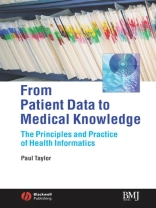How can you make the best use of patient data to improve health
outcomes? More and more information about patients’ health is
stored on increasingly interconnected computer systems. But is it
shared in ways that help clinicians care for patients? Could it be
better used as a resource for researchers?
This book is aimed at all those who want to learn about how IT
is transforming the way we think about medicine and medical
research. The ideas explored here are taken from research carried
out around the world, and are presented by a leading authority in
Health Informatics based at University College London.
This comprehensive guide to the field is split into three
sections:
* What is health informatics? – an introduction
* Techniques for representing and analysing patient data and
medical knowledge
* Implementation in the clinical setting: changing practice to
improve health care outcomes
Whether you are a health professional, NHS manager or IT
specialist, this book will help you understand how data can be
managed to provide the information you and your colleagues want in
the most helpful and accessible way for both you and your
patients.
Tabla de materias
Part One: Three Grand Challenges for Health Informatics.
1 Introduction.
2 Reading and writing patient records.
3 Creation of medical knowledge.
4 Access to medical knowledge.
Part Two: The Principles of Health Informatics.
5 Representation.
6 Logic.
7 Clinical terms.
8 Knowledge representation.
9 Standards in health informatics.
10 Probability and decision-making.
11 Probability and learning from data.
Part Three: Achieving Change.
12 Information technology and organisational transformation.
13 Achieving change through information.
14 Achieving change through information technology.
15 Conclusions.
Index.
Sobre el autor
Paul Taylor, Centre for Health Informatics and Multiprofessional Education, University College London.












